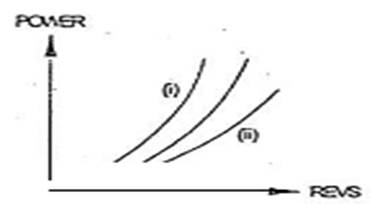Question
(a)
Sketch propeller power curves showing EACH of the following:
ii) The effect of hull fouling:
{ii) Operation in clean hull ballast
conditions
b) Explain how the fitting of a light
propeller may be beneficial.
(c)
Explain how the fitting of a controllable pitch propeller may be
beneficial.
Answer.
The normal propeller curve is a plot of power versus
revs where power is proportional to revs cubed and takes the form of the middle
curve in the sketch.

i) When the hull is fouled, more power is required for
the same revs and the propeller curve will be of increased gradient compared to
the normal curve.
(ii) When
the clean hull is
in the ballast condition, less power is
required for the same revs and the
propeller curve will be of reduced gradient compared to the normal curve
(b) A lighter propeller will have a reduced starting
torque due to the lower mass moment of inertia, but this is minimal when
running since the greater resistance to rotation is from the hydrodynamic
effect which depends upon the geometry of the propeller. The lighter propeller
will however have a lower bending moment at the stern tube and may be
beneficial to bearing life.
c) The
fitting of a CP propeller has the following benefits:
Improved and safer manoeuvring:
Quicker speed of response:
Thrusts infinitely variable between full ahead and
full astern:
No stop starts, full utilisation
of engine power
Stopping times and distances reduced.
Optimum pitch settings for fouled hulls improve
efficiency of power and fuel consumption.
Vibration may be reduced by altering pitch and
revolutions in contrast to revs control only.
Reduced cylinder liner wear and improved life of both
engine and stern tube bearings (constant r.p.m. and
no stops and starts for astern operation).
Simplified main machinery if uni-directional
prime movers are used particularly control systems and reduction gears
permits use of engine driven
auxiliaries.
Reduces air starting capacity requirements
Easier to carry out engine trials.